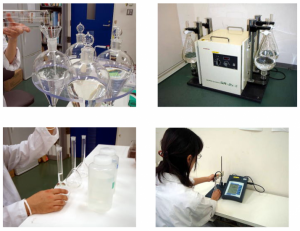以下に、実際に変圧器の過熱が原因となって発生した火災の具体的な事例を紹介します。
1. 経年劣化による絶縁低下と過熱発火
- 設置から46年が経過した変圧器で、巻線内部の絶縁紙や巻線の絶縁被膜が経年劣化し、絶縁低下が発生。
- これにより一次側巻線間で層間短絡が起こり、過電流が流れて発熱し、最終的に発火した。
- この変圧器には温度ヒューズや電気ヒューズなどの過熱保護機能がなく、経年劣化による火災発生と判断された。
2. 内部塵埃堆積・塩分付着による局部過熱と発火
- 可搬型小型変圧器の一次側タップ間に塵埃が堆積し、塩分が付着。これが水分を吸収したことで微小電流が流れ、発熱。
- 発熱で塵埃が乾燥・炭化し、炭化導電路が形成されて局部放電が繰り返され、最終的に発火に至った。
- 設置環境の変化(位置変更により降雨時に水没しやすくなったこと)が要因の一つ。
3. 端子のゆるみや経年劣化による発熱・火災
- 変圧器一次側タップ切替窓付近から炎が上がり、一次側パネル内に焼損跡を確認。
- 詳細調査の結果、端子のゆるみ、製造不良、経年劣化などの物的要因や、雨水浸入、結露、塵埃堆積などの外的要因が火災発生に関与したと考えられる。
4. 絶縁油の過熱・分解による火災
- 地震の影響で変圧器ブッシング部から絶縁油が噴出し、アーク放電(約1,000℃以上)が発生。
- 絶縁油が高温で分解し、可燃性ガスが生成されて引火し、火災が発生。
- 二次側接続母線部ダクト内での火災により、導体やダクトが大きく損傷。
まとめ
変圧器の過熱による火災は、経年劣化や絶縁低下、塵埃・塩分の付着、端子のゆるみ、絶縁油の過熱・分解など多様な要因で発生しています。特に長期間使用された変圧器や、保守点検が不十分な場合にリスクが高まります。定期的な点検と適切な保護装置の設置が、火災防止には不可欠です。
弊社では、絶縁油ガス分析、フルフラール分析、特性試験を行っており、定期点検・確認の一助になれますので、その際はお問合せくださいませ。
Cases of Fires Caused by Transformer Overheating
Below are specific examples of fires that were caused by transformer overheating.
1. Insulation Deterioration Due to Aging and Overheating-Induced Ignition.
In a transformer that had been in operation for 46 years, the insulation paper inside the windings and the insulation coating on the windings deteriorated over time, resulting in reduced insulation performance.
This led to an interlayer short circuit in the primary winding, causing overcurrent and heat generation, which eventually resulted in ignition.
This transformer did not have overheating protection features such as thermal fuses or electrical fuses, and the fire was determined to have been caused by aging deterioration.
2. Localized Overheating and Ignition Due to Accumulated Dust and Salt Contamination.
Dust accumulated between the primary side taps of a portable small transformer, and salt adhered to the area. When this absorbed moisture, a small current flowed, generating heat.
The heat dried and carbonized the dust, forming a carbonized conductive path. Repeated local discharges eventually led to ignition.
One contributing factor was a change in the installation environment (the transformer became more prone to submersion during rainfall due to a change in its location).
3. Heating and Fire Due to Loose Terminals and Aging (Ibaraki Prefecture Reported Case)
Flames were observed near the primary side tap changer window of a transformer, and burn marks were found inside the primary side panel.
Detailed investigation suggested that physical factors such as loose terminals, manufacturing defects, and aging, as well as external factors like rainwater intrusion, condensation, and dust accumulation, contributed to the fire.
4. Fire Caused by Overheating and Decomposition of Insulating Oil.
Due to an earthquake, insulating oil spurted from the transformer bushing, and arc discharge (over 1,000°C) occurred.
The insulating oil decomposed at high temperatures, generating flammable gases that ignited and caused a fire.
The fire in the secondary bus duct caused significant damage to conductors and the duct itself.
Summary
Fires caused by transformer overheating can result from various factors, including aging and insulation deterioration, accumulation of dust and salt, loose terminals, and overheating or decomposition of insulating oil. The risk is especially high in transformers that have been used for long periods or have not been adequately maintained. Regular inspections and the installation of appropriate protective devices are essential to prevent fires.




